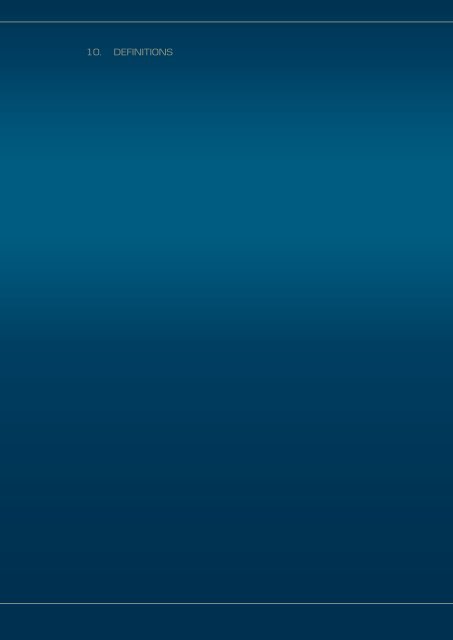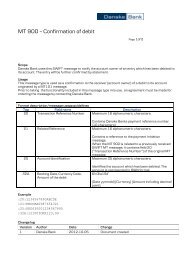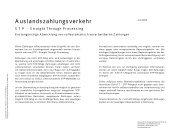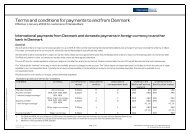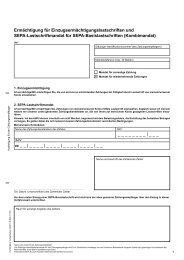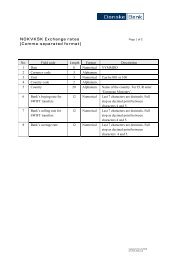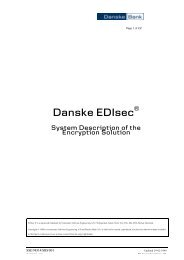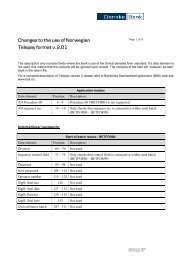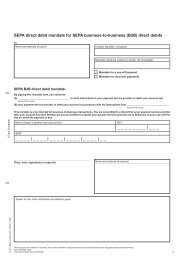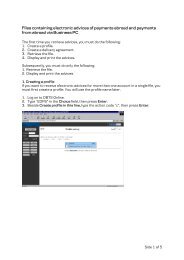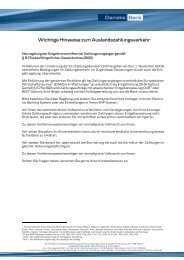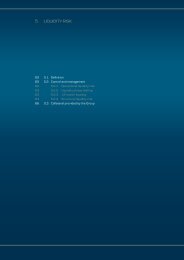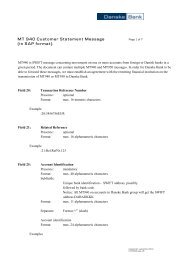10. dEFiNiTiONS - Danske Bank
10. dEFiNiTiONS - Danske Bank
10. dEFiNiTiONS - Danske Bank
Create successful ePaper yourself
Turn your PDF publications into a flip-book with our unique Google optimized e-Paper software.
<strong>10.</strong> DEFINITIONS
ABCP programme<br />
Asset Backed Commercial Paper programme.<br />
All Risk Committee<br />
The All Risk Committee is in charge of implementing the Group’s<br />
• risk appetite process<br />
• overall structure of and development policy for the balance sheet<br />
• targets for capital structure and solvency<br />
• rating strategy<br />
• overall funding structure<br />
• general principles for measuring, managing and reporting on the Group’s risks<br />
• risk policies for relevant business areas<br />
• overall risk exposure guidelines – for example for identifying and managing risk concentrations<br />
– and follow-up measures<br />
• overall investment strategy<br />
• capital deployment<br />
The All Risk Committee consists of members of the Executive Board and the heads of <strong>Danske</strong> Markets<br />
and Risk Management.<br />
<strong>Bank</strong>ing book versus trading book<br />
Credit exposure is divided into credit exposure in the banking book and in the trading book. The banking<br />
book covers items with credit risk that form part of the core banking operations. The trading book<br />
covers items with credit risk that form part of the Group’s trading-related activities.<br />
In capital requirement calculation, a distinction is made between items in the trading book and items<br />
outside the trading book.<br />
Business risk<br />
Business risk is the risk of losses caused by changes in external circumstances or events that harm the<br />
Group’s reputation or earnings. Business risk includes the risk of a decline in earnings due to strategic<br />
decisions (strategic risk).<br />
Capital adequacy rules<br />
The term “capital adequacy rules” refers to the Danish capital adequacy rules stipulated in the Danish<br />
executive order on capital adequacy before the amendment of December 22, 2006.<br />
Commodity risk<br />
Commodity risk is the risk of losses because of changes in commodity prices.<br />
DANSKE BANK RISK MANAGEMENT 2007 DEFINITIONS<br />
99
Counterparty risk<br />
Counterparty risk is the risk of loss resulting from a customer’s default on derivatives contracts with<br />
the Group.<br />
Country risk<br />
Country risk is the risk of losses arising from economic difficulties or political unrest in a country,<br />
including the risk of losses following nationalisation, expropriation and debt restructuring.<br />
CRD rules<br />
The European Union’s Capital Requirements Directives (2006/48/EC and 2006/49/EC), incorporated<br />
in the Danish executive order on capital adequacy of December 22, 2006, which took effect on January<br />
1, 2007. The rules stipulate that the advanced approach for calculating credit risk and operational risk<br />
may first be used on January 1, 2008, and requires approval of the supervisory authority.<br />
Credit risk<br />
Credit risk is the risk of losses because counterparties fail to meet all or part of their payment obligations<br />
towards <strong>Danske</strong> <strong>Bank</strong> Group. Credit risk also includes country, dilution and settlement risk.<br />
Credit risk on assets in the trading book is called counterparty risk and is treated separately.<br />
Credit spread risk<br />
Credit spread risk is the risk of losses because of changes in credit spreads.<br />
<strong>Danske</strong> <strong>Bank</strong>ing Concept<br />
<strong>Danske</strong> <strong>Bank</strong>ing Concept is the Group’s business model. It is based on the principle of a uniform customer<br />
segmentation and service strategy in the individual business areas.<br />
The Concept also includes a uniform organisation and uniform processes in the business areas. To a<br />
great extent, the processes are based on the shared IT platform implemented over the past few years.<br />
The Concept serves to optimise the control measures carried out at Group level by Group Credits and<br />
Group Finance, among others.<br />
Defined benefit plans<br />
In defined benefit plans, the pension agreement contains a provision stipulating the pension benefit<br />
the employee will be entitled to receive on retirement. The benefit is typically stated as a percentage<br />
of the employee’s salary immediately before retirement, but it can also be a percentage of the average<br />
salary during the entire period of employment. The pension benefit will typically be payable for the<br />
rest of the employee’s life, which increases the employer’s uncertainty about the amount of the future<br />
obligations.<br />
Defined contribution plans<br />
In defined contribution plans, there is no guarantee that the employee will obtain a certain amount of<br />
pension benefits. The pension benefits depend on the size of the agreed contributions and developments<br />
in the return on invested pension funds and associated expenses.<br />
Dilution risk<br />
Dilution risk is the risk that the debtor – of purchased receivables – may obtain a reduction of the debt<br />
through set-off, objections based on underlying legal issues or other factors.<br />
Economic capital<br />
Economic capital is the capital, calculated with the Group’s own models, that is necessary to cover<br />
potential losses over the next year at a confidence level of 99.97%, which corresponds to an AA rating.<br />
The calculation of economic capital takes into account all types of risk, including concentration and<br />
migration risks, as well as diversification within the individual risk types. It does not take into account<br />
diversification among various risk types, however.<br />
The calculation of economic capital is based on point-in-time parameters for PD, LGD and CF, and it<br />
will therefore fluctuate with the business cycle. Stress tests are intended to identify the effects of these<br />
fluctuations.<br />
100 DEFINITIONS DANSKE BANK RISK MANAGEMENT 2007
Equity market risk<br />
Equity market risk is the risk of losses because of changes in equity prices.<br />
Exchange rate risk<br />
Exchange rate risk is the risk of losses on the Group’s foreign currency positions because of changes in<br />
exchange rates.<br />
Executive Board’s Credit Committee<br />
Credit applications that exceed the lending authorities of the business areas must be submitted to<br />
the Credit Committee for approval. The local credit departments of the business areas review these<br />
applications before the heads of the local credit departments submit them to the Credit Committee for<br />
approval.<br />
The Credit Committee consists of members of the Executive Board and the management team of Group<br />
Credits. The Committee is also in charge of preparing operational credit policies and approving or rejecting<br />
credit applications involving issues of principle. The Board of Directors determines the lending<br />
authorities. In addition, the Credit Committee participates in decisions regarding the valuation of the<br />
Group’s loan portfolio in connection with the recognition of impairment losses.<br />
Executive Committee<br />
The Executive Committee constitutes the day-to-day executive management. It is headed by the Chairman<br />
of the Executive Board. The Executive Committee is a coordinating forum whose principal objective<br />
is to take an overall view of activities across the Group with particular attention to the interaction<br />
between support functions and product suppliers on the one hand, and individual divisions and<br />
country organisations on the other.<br />
The Executive Committee does not take part in the credit approval process.<br />
Floor risk<br />
Floor risk is the risk of lack of earnings on deposits because market interest rates approach zero.<br />
General risk<br />
General risk is the Group’s risk of losses on its positions because of general changes in market prices,<br />
including interest rates, exchange rates, share prices and commodity prices. It applies to all positions<br />
in the trading book. Exchange rate risk and commodity risk also apply to positions outside the trading<br />
book.<br />
Group Credits<br />
The Group’s credit organisation is led by the head of the central credit department, Group Credits.<br />
Group Credits has overall responsibility for the credit process in all of the Group’s business areas. This<br />
includes the responsibility for developing rating and score models and for applying them in day-today<br />
credit processing in the local units.<br />
Group Finance<br />
Group Finance oversees the Group’s financial reporting and strategic business analysis, including the<br />
performance and analytic tools used by the business units.<br />
The department is also in charge of the Group’s investor relations, corporate governance, capital<br />
structure, M&A and relations with rating agencies. Risk Management is part of Group Finance. As the<br />
Group’s risk monitoring unit, Risk Management has overall responsibility for the Group’s implementation<br />
of the CRD rules, risk models and risk analysis.<br />
ICAAP<br />
In 2006, in preparation for the transition to CRD, the Group established an Internal Capital Adequacy<br />
Assessment Process (ICAAP). This is a collection, expansion and validation of many assessments and<br />
considerations that had also been conducted earlier.<br />
DANSKE BANK RISK MANAGEMENT 2007 DEFINITIONS<br />
101
The Group’s ICAAP includes an evaluation of the capital requirement under Pillar II and an internal<br />
evaluation of the total capital requirement.<br />
The ICAAP identifies and measures the Group’s risks and ensures that it has sufficient capital in relation<br />
to its risk profile. It also ensures that adequate risk management systems are used and further<br />
developed.<br />
At least once a year, an ICAAP report is submitted to the Board of Directors. The report contains the<br />
considerations that should be undertaken during the determination of the capital requirement and<br />
capital targets. The All Risk Committee receives quarterly updates of the ICAAP report.<br />
Impaired claims<br />
Impaired claims cover amounts due from customers subject to individual impairment. Of these, customers<br />
not in default are classified in the Group’s risk category 9, and customers in default are classified<br />
in category <strong>10.</strong><br />
Insurance risk<br />
Life insurance risk is the risk that the year’s returns on customers’ funds are inadequate to cover the<br />
customers’ guaranteed benefits, any necessary increase in life insurance provisions, and other obligations.<br />
Insurance risk also includes the market risk on the assets in which Danica Pension’s equity is<br />
invested.<br />
Interest rate risk<br />
Interest rate risk is the risk of losses because of changes in market interest rates.<br />
Investment-grade ratings<br />
Investment-grade ratings correspond to categories 1 to 4 on the Group’s internal rating scale.<br />
Liquidity risk<br />
Liquidity risk is defined as the risk of losses because<br />
• the Group’s funding costs increase disproportionately<br />
• lack of funding prevents the Group from establishing new business<br />
• lack of funding will ultimately prevent the Group from meeting its obligations<br />
Market risk<br />
Market risk is the risk of losses because the fair value of the Group’s assets and liabilities varies with<br />
changes in market conditions.<br />
Operational risk<br />
Operational risk is the risk of losses owing to<br />
• deficient or erroneous internal procedures and processes<br />
• human or system errors<br />
• external events, including legal events<br />
Operational Risk Committee<br />
This Committee assists the Executive Board in its functions and processes related to operational risk<br />
management. The Committee’s responsibilities include the following:<br />
• implementing a group-wide programme that addresses and manages the Group’s current and<br />
potential operational risk<br />
• processing reports from operational risk management functions<br />
• handling “critical risks”<br />
• preparing management information on issues such as IT security, physical security, business<br />
continuity and compliance<br />
102 DEFINITIONS DANSKE BANK RISK MANAGEMENT 2007
Past due amounts<br />
Past due amounts cover loans and advances from the first day’s unautohorised excess on the individual<br />
facility for customers who are not subject to individual impairment.<br />
Previous solvency rules<br />
This term refers to the solvency rules stipulated in the Danish executive order on capital adequacy<br />
before it was amended on December 22, 2006.<br />
Risk policy<br />
To ensure that the Group’s business areas comply with the approved risk limits, the Board of Directors<br />
has adopted an overall risk policy regulating all risk-taking by the Group.<br />
On the basis of the overall risk policies, operational risk policies are prepared for the main business<br />
areas and submitted to the Group’s All Risk Committee for approval.<br />
Settlement risk<br />
Settlement risk is the risk arising when payments are settled, for example for trades in financial instruments,<br />
including derivatives. The risk arises when the Group remits payments before it can ascertain<br />
that the counterparties’ payments have been received.<br />
SIV<br />
Structured Investment Vehicle<br />
Specific risk<br />
Specific risk is the risk of losses on the Group’s assets in the trading book (excluding derivatives) as a<br />
result of circumstances related to the specific issuer.<br />
Sub-investment-grade ratings<br />
Sub-investment-grade ratings correspond to categories 5 and 6 of the Group’s internal rating scale,<br />
provided that the credit risk is acceptable.<br />
Trading book<br />
See the description under “<strong>Bank</strong>ing book versus trading book”.<br />
DANSKE BANK RISK MANAGEMENT 2007 DEFINITIONS<br />
103


